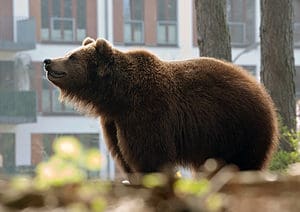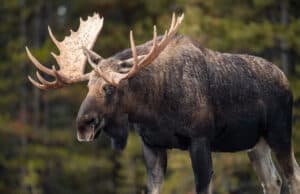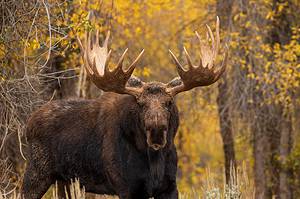One of the symbols of Colorado is the moose. A gigantic and majestic creature that is commonly associated with the state, it’s hard to believe that they emerged there less than a century ago. In this article, we’ll be going over the history of the moose in Colorado, as well as explaining some basics of their behavior and ways you can avoid a negative encounter with one. So, it’s time to test your moose knowledge and learn a thing or two about the Centennial State in the meantime!
Significance of Moose in Colorado: A Brief History

Moose were brought to Colorado in the 1970s because their government decided they had the resources to support the creatures. It seems they were right!
©Phanom Nuangchomphoo/Shutterstock.com
No one knows for certain whether or not moose in Colorado were ever native. While some don’t believe that they were, others think that they were briefly spotted in the 1800s and never seen again. Regardless of what the case may be, the fact remains that everything changed in the 1950s when Colorado’s government debated upon and ultimately decided to bring moose to the state.
The reason they wanted to bring the moose was because they had no natural predators in the area, and they had plenty of space in the state to support the new animal population. With that settled, the reintroduction of moose in the state began in the 1970s. In 1978, moose from the states of Wyoming and Utah were gathered and transplanted into Colorado. This continued over time, in different parts of the state. Their reintroduction turned out to be an excellent idea for Colorado because new opportunities for both hunters and nature observers were unlocked.
Around the United States, in nearly every other area containing moose, their populations have declined. However, in Colorado, their moose population continues to grow! From 2015 to 2021, for instance, the number of moose jumped from 2,500 to 3,500. Though no one knows what the future holds, it’s likely that this number will continue to rise!
Where To Spot Moose in Colorado

Dense moose populations can be found all over the state, especially in the western portion.
©Tom Tietz/Shutterstock.com
If you trace back the root of the word, “moose” actually translates to “eater of twigs.” As the name suggests, you’re going to find these creatures in areas that contain lots for them to munch on. This means places with lots of trees, leaves, and nearby bodies of water to wash it all down. You could run into them in forests or in marshes, but in any case, be careful! Just because they’re big doesn’t mean they don’t have a tendency to fit in and hide out in plain sight. Now, let’s go over some of the most heavily moose-populated areas in Colorado!
State Forest State Park
This area is known as the moose-viewing capital of the state, and for good reason! State Forest State Park has quite a hefty moose population, with over 600 moose calling it home. You can hike or bike down the park’s trails to try and catch a glimpse of the many wild animals that call Colorado home.
North Park
This area is located right near the border separating Colorado and Wyoming. If you’re going to try and spot some Moose in Colorado, this a place that you’ll have great luck in. Although all areas in this county have a surplus of moose, North Park is the place to be!
Arapaho National Wildlife Refuge
Founded back in 1967, Arapaho National Wildlife Refuge isn’t the most accessible spot to get up close and personal with moose, but there are aspects of visiting that make it worth the trip. They have, for instance, an Auto Tour that allows you to see the refuge from the comfort of your vehicle.
The Types of Moose You’ll Find in Colorado

An adult bull Shiras moose can weigh up to 1,200 pounds at its largest.
©equigini/iStock via Getty Images
The kind of moose you’ll find in Colorado is called the Shiras moose. They are the biggest game animal in that state, as an adult moose can weigh upwards of 1,200 pounds. Their coloration can vary a bit, but typically they will have black coats. You can recognize a moose by their large antlers, which shed and regrow each year.
These deer increase in population each year in the spring, after their mating season rolls around. The breeding season (also known as a rut) begins in the middle of September and ends at the beginning of November. Because of the timing of this season, the babies are born in May or June. These babies can come out either as single calves or twin calves. Triplets have been seen before, but they aren’t common.
Are Moose Friendly?

Moose aren’t prone to aggression, but they will defend themselves if they feel threatened!
©Gary Gray/iStock via Getty Images
It’s important to note that moose are not aggressive outright. In fact, the moose is considered an extremely watchable animal as they have less of an inclination to run off than other creatures. This docility combined with how beautiful they are to look at makes them quite popular with nature observers! That being said, you should not take this polite nature for granted and upset a moose.
Friendly or otherwise, moose are wild animals. With that comes a certain unpredictability. Moose aren’t naturally aggressive, but if they feel threatened or uncomfortable, they are known to defend themselves from any perceived threat. As a general rule, keep a reasonable distance. Don’t bother these creatures, and they aren’t likely to bother you. If you find yourself suddenly getting too close to a moose, just slowly back away without making it alarmed.
They might be alright with people, but moose cannot say the same about dogs. The majority of the time, people only experience poor interactions with moose when a dog is involved. This is because dogs resemble their natural predator: The wolf. Because of this historic relationship, moose are generally ill at ease around dogs, and having your canine around them could trigger a very negative reaction. If you go moose-watching, just keep Fido at home.
Thank you for reading! Have some feedback for us? Contact the AZ Animals editorial team.








